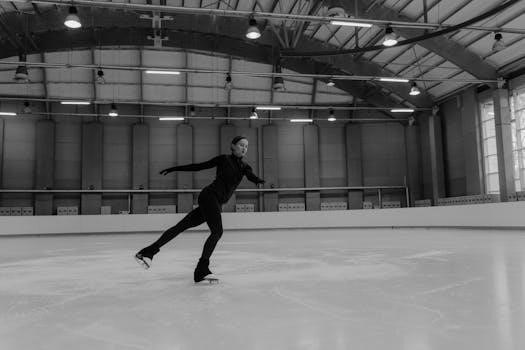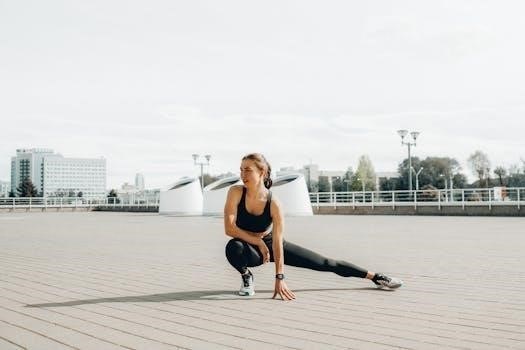Vastus Medialis Exercises PDF⁚ A Comprehensive Guide
This guide provides a comprehensive overview of vastus medialis (VMO) exercises, crucial for knee health and stability․ Strengthening the VMO, the inner quad muscle, supports proper kneecap tracking and reduces pain․ Learn effective exercises, like floor extensions and squats, to enhance VMO function and improve lower body strength․
The vastus medialis oblique, commonly known as the VMO, is a vital component of the quadriceps muscle group, located on the front of the thigh․ As the innermost quadriceps muscle, it plays a critical role in knee joint stabilization and proper patellar tracking․ Understanding the VMO’s anatomy and function is essential for designing effective exercises to strengthen and rehabilitate this muscle․
The VMO’s unique oblique orientation distinguishes it from the other quadriceps muscles․ This specific angle allows it to provide medial support to the patella, preventing lateral displacement during knee movements․ Consequently, a strong VMO is crucial for maintaining optimal knee mechanics and preventing pain and injuries․
Weakness or dysfunction of the VMO can lead to various knee problems, including patellofemoral pain syndrome, where the kneecap doesn’t track properly․ This condition can cause pain, clicking, and instability in the knee joint․ Therefore, targeted exercises aimed at strengthening the VMO are often recommended as part of a comprehensive rehabilitation program․ Recognizing the VMO’s significance is the first step toward implementing effective strategies for knee health and performance․
The following sections will explore the importance of VMO strength, common causes of VMO weakness, and a range of exercises to activate and strengthen this crucial muscle․
Importance of VMO Strength for Knee Health
VMO strength is paramount for maintaining optimal knee health and function․ A well-developed VMO contributes significantly to patellar stability, ensuring the kneecap glides smoothly within its groove during knee flexion and extension․ This proper tracking minimizes friction and stress on the joint, reducing the risk of pain and cartilage damage․ The VMO acts as a dynamic stabilizer, actively counteracting lateral forces that could displace the patella․
Beyond patellar tracking, VMO strength enhances overall knee stability, protecting ligaments and other supporting structures․ Strong VMO muscles improve the knee’s ability to withstand compressive and rotational forces, crucial for activities involving running, jumping, and pivoting․ Adequate VMO strength is also essential for preventing knee injuries in athletes and active individuals․
Conversely, VMO weakness can lead to patellofemoral pain syndrome, a common condition characterized by pain around the kneecap․ This occurs because the weakened VMO is unable to effectively control patellar movement, resulting in abnormal tracking and increased stress on the joint․ Furthermore, VMO weakness may contribute to osteoarthritis and other degenerative knee conditions․
Therefore, prioritizing VMO strengthening exercises is crucial for individuals seeking to maintain healthy knees, prevent injuries, and alleviate pain․ A targeted exercise program can effectively improve VMO strength and function, leading to enhanced knee stability and overall lower limb performance․
Common Causes of VMO Weakness
VMO weakness can arise from a variety of factors, often stemming from imbalances in the lower limb musculature or lifestyle habits․ One prevalent cause is disuse atrophy, where prolonged inactivity or immobilization following an injury leads to muscle wasting, including the VMO․ This is commonly seen after knee surgeries or extended periods of bed rest․
Muscle imbalances also play a significant role․ Overdeveloped vastus lateralis, the outer quadriceps muscle, can overpower the VMO, leading to its relative weakness․ This imbalance can be exacerbated by training regimens that prioritize the outer quads over the inner quads․ Similarly, weak hip abductors and external rotators can indirectly affect VMO activation, as these muscles contribute to overall lower limb stability and alignment․
Poor posture and biomechanics can also contribute to VMO weakness․ Individuals with excessive pronation (flat feet) or knock-knees (genu valgum) may experience altered lower limb alignment, which can inhibit VMO activation during movement․ Habitual slouching or poor sitting posture can also contribute to muscle imbalances and decreased VMO engagement․
Furthermore, nerve injuries or conditions affecting the nerves that innervate the VMO can directly impair its function, leading to weakness․ Certain medical conditions, such as arthritis, can also cause pain and inflammation in the knee, which can lead to decreased VMO activation and subsequent weakness․
Addressing these underlying causes is crucial for effectively strengthening the VMO and restoring proper knee function․ A comprehensive approach that includes targeted exercises, postural correction, and addressing any underlying medical conditions is essential for achieving optimal results․

Effective Vastus Medialis Exercises
Targeted exercises are essential for strengthening the VMO․ These include isometric contractions, floor extensions focusing on isolation, and variations of squats․ Wall squats using a Swiss ball and step-up exercises are also beneficial․ Proper form is crucial to maximize VMO activation and avoid injury․
Isometric Contraction Exercises
Isometric contraction exercises are a great starting point for strengthening the vastus medialis, especially if you’re recovering from an injury or experiencing knee pain․ These exercises involve contracting the muscle without any joint movement, making them low-impact and safe․
One simple isometric exercise can be performed sitting with your leg straight․ Place a rolled-up towel or a small ball underneath your knee․ Gently press the back of your knee down into the towel or ball, contracting your quadriceps muscle․ Hold this contraction for 5-10 seconds, then relax․ Repeat this exercise 10-15 times․
Another variation involves seated isometric VMO activation․ Sit tall with proper posture, focusing on engaging the inner quad muscle․ Push your foot into the floor as if you’re trying to extend your knee, but without actually moving it․ Maintain the contraction, feeling the muscle engage above your knee․ This will help target and strengthen the VMO specifically․
Remember to maintain proper form and listen to your body․ If you experience any pain, stop the exercise immediately․ Isometric exercises can be easily incorporated into your daily routine, making them a convenient and effective way to improve VMO strength․

Floor Extension Exercise
The floor extension exercise is a straightforward yet effective method for isolating and strengthening the vastus medialis․ This exercise focuses on controlled movements to engage the inner quad muscle, promoting knee stability and reducing pain․ It’s particularly beneficial for individuals seeking to improve patellar tracking and overall knee function․
To perform the floor extension, begin by sitting on the floor with your legs extended straight in front of you․ Maintain a tall posture, ensuring your back is straight and your core is engaged․ Slowly extend one leg, lifting it a few inches off the ground while keeping your knee straight․ Focus on feeling the contraction in your vastus medialis as you lift and hold the leg․
Hold the extended position for a few seconds, emphasizing the muscle engagement․ Gradually lower the leg back to the starting position, maintaining control throughout the movement․ Repeat this exercise for 10-15 repetitions on each leg․ To increase the challenge, you can add ankle weights or resistance bands․
Proper form is crucial for maximizing the benefits of this exercise․ Avoid rounding your back or using momentum to lift your leg․ Focus on controlled, deliberate movements to target the VMO effectively․ This exercise can be incorporated into your regular workout routine to enhance knee strength and stability․
Squats⁚ Traditional and Variations
Squats are a fundamental exercise for overall leg strength, and incorporating variations can specifically target the vastus medialis․ Both traditional and modified squats engage the quadriceps, hamstrings, and glutes, promoting functional fitness and knee stability․ By adjusting your technique, you can emphasize VMO activation․
The traditional squat involves standing with feet shoulder-width apart, toes slightly pointed outward․ Lower your body as if sitting in a chair, keeping your back straight and chest up․ Ensure your knees track over your toes and descend until your thighs are parallel to the ground, or as low as comfortably possible․ Push through your heels to return to the starting position․
To enhance VMO engagement, consider variations like the narrow-stance squat․ By positioning your feet closer together, you increase the demand on the inner quad muscles․ Another effective variation is the partial squat, where you only descend to a half squat position․ This focuses on the upper range of motion, which heavily activates the VMO․
Additionally, incorporating resistance bands around your thighs can further challenge the VMO during squats․ The band forces you to actively push your knees outward, increasing muscle activation․ Remember to maintain proper form throughout all squat variations to prevent injury and maximize the benefits of the exercise․
Wall Squats with Swiss Ball
Wall squats with a Swiss ball offer a controlled and supportive way to strengthen the vastus medialis while improving stability and balance․ This exercise reduces stress on the knee joint compared to traditional squats, making it suitable for individuals with knee pain or those recovering from injuries․ The Swiss ball adds an element of instability, further engaging the VMO for enhanced activation․
To perform this exercise, place a Swiss ball between your lower back and a wall․ Stand with your feet shoulder-width apart, slightly away from the wall․ Slowly squat down, allowing the ball to roll along your back, until your thighs are parallel to the ground or as low as comfortably possible․ Maintain a straight back and engage your core throughout the movement․
As you squat, focus on keeping your knees aligned with your toes and avoiding any inward collapsing of the knees․ This helps to ensure proper VMO activation and prevents potential knee strain․ The wall provides support, allowing you to concentrate on maintaining correct form and targeting the desired muscle groups․
To increase the challenge, you can hold a light dumbbell in each hand or perform the exercise on a slightly unstable surface․ Remember to control the movement throughout the entire range of motion and avoid bouncing at the bottom of the squat․ This controlled approach maximizes muscle engagement and minimizes the risk of injury․
Step-Up Exercises for VMO Activation
Step-up exercises are highly effective for activating and strengthening the vastus medialis oblique (VMO), a key muscle for knee stability and proper patellar tracking․ This exercise mimics everyday movements like climbing stairs, making it a functional and practical addition to any VMO strengthening program․ By focusing on controlled movements and proper form, you can effectively target the VMO and improve knee health․
To perform a step-up, begin by standing in front of a stable platform or step․ The height of the step should be challenging but allow you to maintain good form․ Place one foot firmly on the center of the step, ensuring your entire foot is in contact with the surface․ Engage your core and lean slightly forward from your hips․
Drive through your heel on the step to lift your body up, extending your knee and hip until you are standing fully on the step․ Focus on squeezing your VMO as you reach the top of the movement․ Slowly lower yourself back down to the starting position, controlling the descent to maximize muscle engagement and prevent injury․
Repeat the movement for the desired number of repetitions, then switch legs․ To increase the challenge, you can hold dumbbells in each hand or use a higher step․ Emphasize maintaining proper alignment throughout the exercise, keeping your knee tracking directly over your toes and avoiding any inward or outward rotation․ This will ensure optimal VMO activation and protect your knee joint․
Leg Extension Exercises
Leg extension exercises, when performed correctly, can contribute to vastus medialis (VMO) strengthening, although they should be approached with caution․ These exercises involve extending the leg against resistance, typically using a leg extension machine․ While they primarily target the quadriceps muscle group, adjustments in technique can emphasize VMO activation․
To maximize VMO involvement, focus on the final 30 degrees of the extension․ This range of motion is where the VMO is most actively engaged in stabilizing the patella․ Avoid using excessive weight, as this can compromise form and potentially lead to knee joint stress․ Instead, prioritize controlled movements and a full range of motion within a pain-free zone․
Proper setup on the leg extension machine is crucial․ Ensure your knees are aligned with the axis of the machine, and your back is supported․ As you extend your leg, consciously contract your VMO, focusing on the feeling of the muscle engaging near the inner part of your knee․ Avoid locking out your knee at the top of the movement, as this can place undue stress on the joint․
Consider incorporating variations like performing the exercise with your toes slightly pointed outward, which can further enhance VMO activation․ Remember to listen to your body and discontinue the exercise if you experience any pain․ Leg extensions should be part of a comprehensive VMO strengthening program, complementing other exercises like squats and step-ups for balanced muscle development and knee health․

Integrating VMO Exercises into a Training Program
Integrating vastus medialis (VMO) exercises into a well-rounded training program requires a strategic approach․ It’s not about isolating the VMO entirely but rather incorporating exercises that effectively engage it within the larger context of lower body strength and stability; Start by assessing your current fitness level and any existing knee issues․ If you’re new to exercise or have knee pain, consult with a physical therapist or qualified trainer․
Begin with a foundation of basic exercises like bodyweight squats, wall squats with a Swiss ball, and step-ups․ These exercises promote overall leg strength while also activating the VMO․ As you progress, gradually introduce more targeted VMO exercises, such as leg extensions with a focus on the final 30 degrees of extension and isometric contractions․
Frequency and intensity are key․ Aim for 2-3 VMO-focused workouts per week, allowing for adequate rest and recovery between sessions․ Start with lower repetitions and sets, gradually increasing the load or resistance as your strength improves; Pay close attention to your form, ensuring proper alignment and controlled movements․
Remember that VMO strengthening is most effective when combined with exercises that target other muscles around the knee, including the hamstrings, glutes, and other quadriceps muscles․ This holistic approach ensures balanced muscle development and optimal knee joint function․ Finally, listen to your body and adjust your training program as needed to avoid overtraining and potential injuries․

Considerations and Precautions
When embarking on a vastus medialis (VMO) strengthening program, several considerations and precautions are essential to ensure safety and effectiveness․ First and foremost, listen to your body․ Pain is a signal that something is not right, and pushing through it can lead to further injury․ If you experience any sharp or persistent pain during or after exercise, stop immediately and consult with a healthcare professional․
Proper form is crucial․ Incorrect technique can place undue stress on the knee joint and negate the benefits of the exercises․ If you’re unsure about your form, seek guidance from a qualified trainer or physical therapist․ They can provide personalized instruction and ensure that you’re performing the exercises correctly․
Individuals with pre-existing knee conditions, such as osteoarthritis or patellofemoral pain syndrome, should exercise caution and work closely with their healthcare provider․ Certain exercises may be contraindicated or require modifications to accommodate specific limitations․ Start with a low intensity and gradually increase the difficulty as tolerated․
Warm-up before each workout to prepare your muscles for exercise and cool down afterward to promote recovery․ Stretching the quadriceps and hamstrings can also help improve flexibility and reduce the risk of injury․
Finally, be patient and consistent․ Strengthening the VMO takes time and effort․ Don’t expect overnight results, and stick with your program to reap the long-term benefits of improved knee stability and function․ Remember to prioritize safety and listen to your body throughout the process․